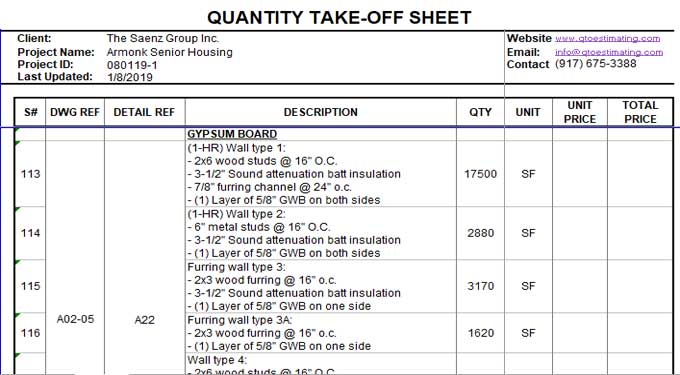
How does Quantity Takeoff work in the Construction Industry?
Quantity takeoffs require some expertise and effort. But you will be rewarded when you provide clients with accurate information that allows them to make more informed choices. As a result, it adds value to the project and keeps everyone on track with deadlines and budgets.
The quantity takeoff is an in-depth estimate of all the inputs that will be necessary for a construction project. It is from this that costs are determined by itemizing the amount of material and labor required. Technology has improved the accuracy and speed of calculations in many aspects of the construction industry.
Define Quantity Take off
Bidding begins with a quantity takeoff, which determines how much work will be required for a particular project. Quantity takeoffs include labor and equipment requirements as well as material requirements for a project.
In contrast to cost estimates, it only quantifies the amount of work and resources needed to complete a project, not how much it will cost. This is simply a method of determining how much work and resources are required.
Quantity Take off Workflow
Consider a quantity takeoff for constructing a concrete foundation. Physical materials, such as reinforcing materials and concrete, would need to be taken into account.
The number of hours and days the crew and equipment would need to be on the construction site would also be calculated. Neither the quantity nor the costs of the project would be included in the estimate.
Contractors, architects, and engineers may take part in a quantity takeoff. Identifying a project's scope and cost is the first step. An estimator creates a budget or proposal for the project based on information from a takeoff.
Quantity Take off Components
Linear Length: Taking off materials such as pipes and lumber requires estimating their linear lengths. The length of the PVC pipe required would be extrapolated based on the blueprints, rather than calculated.
Weight: Additionally, you need to know the gross weight of the project as well as the number of materials it requires. An estimate of transportation is also based on this information.
Cubic Volume: Concrete or earthworks that are three-dimensional are measured with this method. A length is equal to the square root of the width multiplied by the height.
Unit Count: During a unit count, all the materials needed for the project are counted, including doors, handles, sinks, light fixtures, and all the other items that will be installed inside the building. Prior to estimating costs, this is an excellent step because you can multiply each unit's number by its price later.
Surface Area: It is necessary to estimate the surface area of materials such as flooring and sheetrock. Multiply the length by the width of the area to get the equation. As an example, a room measuring 24 by 36 feet would have 864 square feet of surface area.
Difference between Digital takeoff & Manual Takeoff
Blueprints and other design documents can usually be read by takeoff software. As a result, it automatically gathers the materials needed for the project. Errors are significantly reduced by these automated construction estimators. As a result, taking a digital approach is more likely to yield accurate quantity takeoff information.
The estimator uses the manual approach by looking at blueprints and measuring all the materials and surface area of the project. With this approach, estimating materials and labor accurately requires experience and precision. Moreover, the process takes a considerable amount of time.
Benefits of Quantity Takeoff
Communication: Your potential client can make an informed decision if you provide them with a detailed quantity of takeoff. It may be difficult to negotiate a budget with a price quote without justification, but an accurate budget with a breakdown of materials, labor, and equipment provides leverage. The act may help you win bids and build trust at the beginning of a project.
Accurate Cost Estimation: You can have a quantity takeoff at the beginning of a project will likely result in more accurate cost estimates. You won't have to ballpark your estimate since you will know exactly what's needed to complete the project. Calculate costs by researching supply prices and multiplying them by the number you need based on the quantities you have on hand. Furthermore, you will learn if your project qualifies for bulk order discounts.
To get more details, watch the following video tutorial.
Video Source: ConX
Time Saving: The use of an accurate quantity takeoff saves time that would otherwise be lost due to a lack of materials or the delivery of the wrong materials. A detailed takeoff can also help you determine the lead time for everything you need since shipping times are slow and supplies are limited worldwide.


